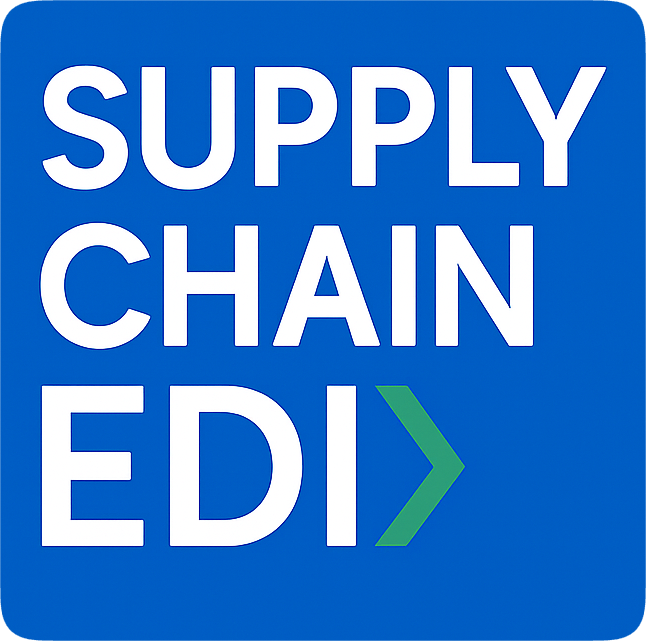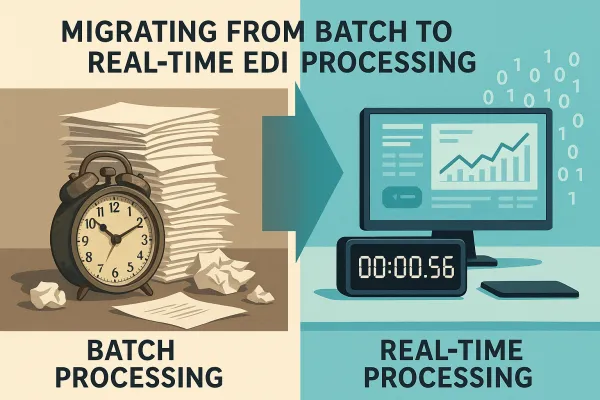Real-Time EDI Integration Architecture: The Complete Implementation Guide for CSRD-Compliant Supply Chain Data Exchange in 2025

EU companies started reporting under new sustainability requirements in 2025, and companies must disclose data on their greenhouse gas emissions, energy consumption, water usage, and waste management practices with all reported data needing to be digitally tagged and audited. The problem? Scope 3 emissions typically represent 70–90% of a company's carbon footprint, and starting in 2025 (for some) and expanding by 2028, thousands of EU companies will be required to disclose them with granular supply chain visibility. Meanwhile, most B2B data still flows through scheduled EDI batches.
The gap between regulatory demands and technical reality creates a clear imperative: supply chain organizations need real-time EDI integration architectures that can satisfy both CSRD compliance automation requirements and operational efficiency needs. Hybrid gateways that accept an API on your side and translate it to X12/EDIFACT only for partners that still need one are becoming the bridge between legacy EDI infrastructure and modern compliance demands.
The Business Case for Hybrid EDI-API Architecture
Running parallel systems costs more than you think. Most companies maintaining separate EDI and API infrastructures spend 40-60% more on integration overhead compared to unified platforms. But the real cost comes from compliance gaps.
Just 22% of the more than 100 companies surveyed feel fully prepared to comply with upcoming regulations like the CSRD, largely because their current batch-oriented systems can't provide the granular, real-time visibility that regulations demand. Companies will need to have "measurable, outcome-oriented and time-bound targets" in place to track their progress on addressing material risks and impacts throughout their value chain. In this way, the directive connects the dots between sustainability due diligence and reporting.
Hybrid EDI-API architecture solves this by maintaining your existing partner relationships while adding real-time capabilities where needed. Consider the operational differences: traditional EDI processes an 850 purchase order in batch mode, potentially taking hours for confirmation. The same transaction through a hybrid gateway can trigger real-time inventory checks via API while still delivering the familiar X12 format to partners who need it.
Modern platforms like Cargoson, alongside solutions from Manhattan Active and Blue Yonder, now offer these hybrid capabilities. The cost comparison typically shows 25-35% operational savings within 18 months, mainly through reduced manual intervention and faster exception handling.
Core Architecture Components and Design Patterns
Think of hybrid EDI-API architecture as a translation layer that speaks multiple languages fluently. Real-time (API) and file-based batch (EDI) processes complement each other seamlessly when these processes are running on the same platform and can interact with each other. The BIS Platform is a cloud-based platform that empowers exactly this type of one-platform approach.
The architecture requires three core components:
Message Routing Engine: This determines whether incoming data gets processed as real-time API calls or batched EDI transactions. Rules might specify that inventory updates trigger immediate APIs while invoices (810 transaction sets) continue through traditional EDI workflows.
Data Transformation Layer: The heavy lifting happens here. An API call for shipment status gets mapped to EDI 214 fields, while preserving real-time response times. Most implementations use JSON-to-X12 transformation templates that can be customized without coding.
Error Handling and Reconciliation: When APIs fail, the system needs to route transactions back through EDI channels automatically. This requires comprehensive monitoring of both synchronous API responses and asynchronous EDI acknowledgments (997/999 functional acknowledgments).
Webhook configurations become critical for CSRD compliance. Set up endpoints that capture emissions data in real-time from transport execution systems, then aggregate this data for both immediate operational decisions and regulatory reporting. The webhook URL structure typically follows: `/api/v1/emissions/{shipment_id}/capture` with automatic rollup to daily/weekly sustainability dashboards.
Implementation Strategy: The Gradual Migration Approach
Don't try to migrate everything at once. Run a short pilot and keep the old file feed open until loads flow smoothly. Pick one trading partner who's willing to test dual modes, then track two metrics obsessively: error rates and manual intervention time.
Phase 1: Status Updates Only
Start with non-transactional data. Convert shipment status calls (214 EDI transactions) to REST API endpoints. Partner systems continue receiving familiar EDI formats, but your internal systems get real-time updates. Track response times: APIs should deliver status updates in under 2 seconds versus EDI's typical 15-30 minute batch cycles.
Phase 2: Transactional Data with Dual Processing
Add purchase orders (850) and advance ship notices (856) while maintaining EDI fallback. Configure your system to send API calls first, then EDI backup if APIs fail. This redundancy costs about 15% more in processing overhead but eliminates single points of failure during transition.
Phase 3: Full Integration with Selective EDI
Move to API-primary operations with EDI only for partners who haven't upgraded. Systems like Transporeon, nShift, and Cargoson support this staged approach, letting you gradually shift transaction volumes while monitoring performance metrics.
The biggest challenge? Partner buy-in still tops the list. Schema drift (the way field meanings change over time) runs second, and security hardening rounds out the top three. Address partner concerns early by demonstrating improved data accuracy and faster problem resolution.
CSRD Compliance Through Real-Time Data Architecture
Unlike first generation environmental legislation that only focused on a company's own footprint, CSRD goes straight to the supply chain, meaning that organizations must now take responsibility for all of their upstream suppliers. This creates an immediate data collection challenge that traditional EDI can't solve alone.
Real-time hybrid architectures enable automated Scope 3 data collection by capturing emissions data at the transaction level. When a shipment status API call comes in, the system simultaneously logs fuel consumption, route efficiency, and vehicle load factors. This granular data gets aggregated for both operational dashboards and quarterly CSRD reports.
The workflow typically looks like this: carrier systems send real-time GPS and fuel data via API calls, your transport management system processes this for immediate operational decisions, and sustainability data gets automatically tagged and stored for audit trails. All reported data will need to be digitally tagged and audited, ensuring transparency, which requires robust data lineage tracking that batch EDI systems struggle to provide.
Platforms like Cargoson integrate with carrier systems to enable automated emissions tracking, alongside other carrier integration software. The key is setting up APIs that capture environmental data without disrupting existing EDI workflows. Partner carriers continue sending familiar 214 shipment status EDI transactions while simultaneously providing emissions data through separate API endpoints.
Overcoming Common Implementation Challenges
Every implementation hits the same three roadblocks: partner resistance, technical complexity, and security concerns. Here's how successful companies navigate each.
Partner Resistance
Your biggest 3PL partner doesn't want to change their EDI setup that's worked for 15 years. Solution: don't ask them to. Hybrid gateways that accept an API on your side and translate it to X12/EDIFACT only for partners that still need one let you modernize internally while partners see no disruption.
Schema Drift Management
API field definitions change faster than EDI standards. Yesterday's `delivery_date` becomes today's `estimated_delivery_window`. Set up automated schema validation that compares API responses against expected formats, with alerts when drift exceeds 5% variance from baseline.
Security Considerations
APIs create more attack surfaces than EDI's traditional VAN channels. Implement OAuth 2.0 tokens with 4-hour expiration cycles, rate limiting at 1000 calls per partner per minute, and comprehensive logging of all API activities. Most hybrid platforms, including solutions integrated with SAP TM and 3Gtms, provide these security features out of the box.
Integration with existing systems requires careful planning. If you're running SAP TM, ensure your hybrid platform can handle SAP's specific data formats and timing requirements. Cargoson fits well in multi-system ecosystems, offering pre-built connectors for major TMS platforms alongside custom API development capabilities.
Performance Monitoring and Optimization Framework
Real-time systems fail fast, which means your monitoring needs to be faster. Traditional EDI monitoring checks for file transfers every 15-30 minutes. API monitoring needs sub-minute alerting.
Build dashboards that show four key metrics in real-time:
Transaction Success Rates: Track API call success rates versus EDI transaction completion rates. Healthy hybrid systems maintain 99.5%+ success rates for both channels, with automatic failover when either drops below 95%.
Response Time Distribution: APIs should respond in under 3 seconds for 95% of calls. EDI transactions typically process within 30 minutes for 95% of batches. Monitor both and alert when response times exceed these thresholds.
Error Classification and Resolution: Not all errors are equal. Network timeouts get automatic retries. Data validation errors need human intervention. Authentication failures require immediate security review. Classify errors by type and automate responses where possible.
Partner-Specific Performance: Some partners will struggle more than others with API adoption. Track performance by partner to identify who needs additional support or should remain on EDI-only paths longer.
SLA monitoring becomes more complex with hybrid systems. You're measuring both internal processing times and external partner response rates across multiple channels. Most companies find they need dedicated monitoring platforms rather than relying on basic system logs. Platforms with built-in monitoring capabilities, like those offered by Cargoson among others, provide comprehensive visibility across both EDI and API transactions.
Set up automated alerting for compliance-critical transactions. CSRD reporting depends on complete data capture, so missing emissions data or incomplete supply chain visibility needs immediate attention. Configure alerts when sustainability data collection drops below 98% completeness for any 24-hour period.
The monitoring framework should also track cost optimization opportunities. Real-time APIs often cost more per transaction than batch EDI, but they enable operational efficiencies that more than offset the additional expense. Monitor transaction costs alongside operational benefits to maintain positive ROI as you scale the hybrid architecture.
Start small, measure everything, and expand gradually. The companies succeeding with CSRD-compliant real-time integration focus on operational value alongside regulatory requirements. Your hybrid EDI-API architecture should make daily operations more efficient while automatically capturing the sustainability data that regulators demand.





